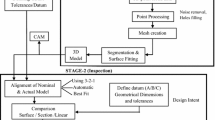Abstract
Many different applications of online product inspections have found a significant advantage by the use of 3D scanners, especially when working with complex surfaces (free-form,…), where traditional inspection tools proved to have significant limitations. Unfortunately, there are not only success stories, but also several situations in which the approach towards 3D scanner technologies has been unsuccessful. This is mainly due to the fact that it is hard to understand which 3D scanner solution is the best to adopt and which working protocol is to be followed in order to obtain the best results from a specific application. These problems are often caused by the absence of a long expertise in 3D scanners and by the presence of inappropriate technical sheets. These last are, in fact, quite fragmented and inhomogeneous and only provide little information about the device behavior in the different working scenarios since they tend to be more oriented to the theoretical metrological performances. Most of the time, this information is not useful for users, who need to have a unique map showing both 3D scanner technical performances and their correlations to the different working scenarios in order to be able to compare the several available systems and to get a better understanding of their usage. In order to provide a solution to this problem, this paper proposes to create a customer benchmarking methodology that is a mixture of benchmark geometry designs and experiment sets. This benchmarking methodology will be focused on the simulation of a computer-aided inspection working scenario and carried out by using the quality function deployment method, in order to be oriented towards customer needs.
Similar content being viewed by others
References
Yau HT, Menq CH (1995) Automated CMM path planning for dimensional inspection of dies and moulds having complex surfaces. Int J Mach Tools Manuf 35:861–876
Lartigue C, Mehdi C, Thibaut F (2006) Scan planning strategy for a general digitized surface. J Comput Inf Sci Eng 6:331
Wu Y, Singh P, Kaucic R, Chen J, Little F (2007) Multimodal industrial inspection and analysis. J Comput Inf Sci Eng 7:102–107
Sarfraz M (2006) Computer-aided reverse engineering using simulated evolution on NURBS. Virtual Phys Prototyping 1(4):243–257 December
Creehan K, Bidanda B (2006) Computer-aided reverse engineering of the human musculoskeletal system. Virtual Phys Prototyping 1(2):83–91 June
Marshall SJ, Whiteford DN, Rixon RC (2001) Assessing the performance of 3D whole body imaging systems. In: Proc 6th Numérisation 3D/Scanning 2001 Congress, Paris, 4–5 April 2001
Rioux M (1997) Colour 3-D electronic imaging of the surface of the human body. Opt Lasers Eng 28:119–135 (NRC Also, SPIE Proceedings, Automatic Systems for the Identification and Inspection of Humans, San Diego, CA. July 28–29, 1994. Vol. 2277. pp. 42–54. NRC 3834)
El-Hakim SF, Beraldin JA, Blais F (1995) A comparative evaluation of passive and active 3-D vision systems. In: Proc. Dig. Photogram., St-Petersburg, 25–30 June 1995
Paakkari J, Moring I (1992) Method for evaluating the performance of range imaging devices. Proc. industrial applications of optical inspection, metrology, and sensing, SPIE-1821. SPIE, Bellingham, pp 350–356
Besl PJ (1988) Range imaging sensors. Mach Vis Appl 1:127–152. doi:10.1007/BF01212277
Prieto F, Redarce T, Lepage R, Boulanger P (2002) An automated inspection system. Int J Adv Manuf Technol 19:917–925 doi:10.1007/s001700200104
Kogure M, Akao Y (1983) Quality function deployment and Cwqc Japan. Qual Prog 16:25–29
Almannai B, Greenough R, Kayasdasdas J (2008) A decision support tool based on QFD and FMEA for the selection of manufacturing automation technologies. Robot Comput Integr Manuf 24(4):501–507 August
Kwong CK, Chen Y, Bai H, Chan DSK (2007) A methodology of determining aggregated importance of engineering characteristics in QFD. Comput Ind Eng 53(4):667–679 November
Asi (1987) Quality Function Deployment. Executive Briefing, American Supplier Institute Inc., Dearborn (Mi)
Strand TC (1985) Optical three-dimensional sensing for machine vision. Opt Eng 24(1):33–40
Clark J, Wallace AM, Pronzato G (1998) Measuring range using triangulation sensors with variable geometry. IEEE Trans Robot Autom 14(1):54–60. doi:10.1109/70.660843
Simple 3D (2006) 3D scanners, digitizers, and software for making 3D models and 3D measurements. http://www.simple3d.com
Clark J (2000) Implementing non-contact digitization techniques within the mechanical deign process. Sens Rev 20(3):195–201
Lockett S (1999) Reverse engineering: an overview and a real time industrial case study. Time Compress Technol 7(3):54–60
American National Standard for Automated Vision Systems – Performance Test – Measurement of Relative Position of Target Features in Two-Dimensional Space. ANSI/AVA A15.05/1 – 1989
Urban GL, Hauser JR (1993) Design and marketing of new products. Prentice-Hall, Englewood Cliffs, pp 267–279 cap 10
Box GE, Hunter WG, Hunter JS, Hunter WG (2005) Statistics for experimenters: design, innovation, and discovery, 2nd edn. Wiley, New York (ISBN: 0471718130)
Kerzner H (2004) Advanced project management, 2nd edn. Wiley, New York (ISBN 978–0471472841 December 1)
Author information
Authors and Affiliations
Corresponding author
Rights and permissions
About this article
Cite this article
Vezzetti, E. Computer aided inspection: design of customer-oriented benchmark for noncontact 3D scanner evaluation. Int J Adv Manuf Technol 41, 1140–1151 (2009). https://doi.org/10.1007/s00170-008-1562-x
Received:
Accepted:
Published:
Issue Date:
DOI: https://doi.org/10.1007/s00170-008-1562-x




